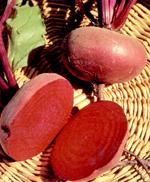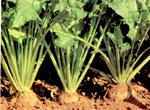| Fruits |
Vegetables
|
Beetroot, Beta vulgaris var. esculenta / Chenopodiaceae
|
Note: Composition for 100 g. of fresh product Values in ( min. - max. ) format. | |
| Energy: 25.00-41.23 kcal Fats: 0.10-0.10 g Fibres: 1.90-2.53 g Fat Acids Polyunsat.: 0.10-0.10 gMinerals Calcium: 17.00-29.00 mgZinc: 0.344-0.400 mg Chlorine: 59.00-82.00 mg Phosporus: 25.00-51.00 mg Iron: 0.80-1.00 mg Magnesium: 11.00-25.00 mg Manganese: 0.155-0.700 mg Potasium: 336.00-380.00 mg Selenium: 0.620-0.620 µg Sodium: 58.00-66.00 mg Iodine: 0.400-0.400 µg | Proteins: 1.00-1.70 kcal Carbohidrates: 5.30-8.38 g Liposoluble Vitamins A Retinol: 1830.00-1830.00 µgA Carotenoids: 11.00-20.00 µg E or Tocoferol: 0.053-0.053 mg Liposoluble Vitamins B1 or Thiamine: 0.010-0.036 mgB2 or Riboflavine: 0.010-0.042 mg B3 or Niacine: 0.100-1.300 mg B5 or Pantothenic Acid: 0.120-0.130 mg B6 or Piridoxine: 0.030-0.050 mg B9 or Folic Acid: 5.00-15.00 mg C or Ascorbic Acid: 5.00-15.00 mg |
|
Note: Composition for 100 g. of fresh product Values in ( min. - max. ) format. | |
| Energy: 46.00-46.00 kcal Fats: 0.10-0.10 g Fibres: 1.90-1.90 g Minerals Calcium: 29.00-29.00 mgZinc: 0.50-0.50 mg Phosporus: 87.00-87.00 mg Iron: 0.80-0.80 mg Magnesium: 16.00-16.00 mg Manganese: 0.90-0.90 mg Potasium: 510.00-510.00 mg Sodium: 110.00-110.00 mg | Proteins: 2.30-2.30 kcal Carbohidrates: 9.50-9.50 g Liposoluble Vitamins A Retinol: 0.00-0.00 µgA Carotenoids: 27.00-27.00 µg Liposoluble Vitamins B1 or Thiamine: 0.01-0.01 mgB2 or Riboflavine: 0.01-0.01 mg B3 or Niacine: 0.10-0.10 mg B5 or Pantothenic Acid: 0.10-0.10 mg B6 or Piridoxine: 0.04-0.04 mg B9 or Folic Acid: 5.00-5.00 mg C or Ascorbic Acid: 5.00-5.00 mg |

Beetroot is the large and fleshy root growing in the plant of the same name, eaten as a vegetable. Its superficial, thin and smooth skin has a wide range of colours, from purple-pink and reddish-orange to a brownish tone. The pulp has a sweet taste and it is usually of a dark crimson red colour with purple tinges.
Nutrition and eating
The beetroot is an excellent source of a wide range of nutrients among which stand out the carbohydrates, fibre, minerals (potassium, calcium, iron, phosphorus and sodium) and vitamins (pro-vitamin A, niacin and vitamin C).
The fruit
 Beetroot is the large and fleshy root growing in the plant of the same name, eaten as a vegetable. Its superficial, thin and smooth skin has a wide range of colours, from purple-pink and reddish-orange to a brownish tone. The pulp has a sweet taste and it is usually of a dark crimson red colour with purple tinges. Sometimes it has white concentric circles; this is an undesired characteristic. However, some beetroot varieties have white or yellow flesh.
Beetroot is the large and fleshy root growing in the plant of the same name, eaten as a vegetable. Its superficial, thin and smooth skin has a wide range of colours, from purple-pink and reddish-orange to a brownish tone. The pulp has a sweet taste and it is usually of a dark crimson red colour with purple tinges. Sometimes it has white concentric circles; this is an undesired characteristic. However, some beetroot varieties have white or yellow flesh. There are three varieties of beetroot; the common or red beetroot is the one consumed as a vegetable. The other two are sugar beet and mangelwurzel. The first one is of a white colour; it has been cultivated to obtain sugar since the XVIth century. Mangelwurzel is chiefly used as cattle food.
Beetroot has a low energetic value with a scarce content of lipids and proteins. Each 100 grams of edible fresh produce provides with 25-41 kcal of energetic value. Apart from water, the greatest components of this vegetable are carbohydrates. The vitamins of group B are important, specially the folic acid, being the latter found in greater amounts. However, it is one of the vegetables with less vitamin C and A content.
It is not recommendable to freeze raw beetroot since they soften during defrosting; however, it is possible to freeze them once boiled. They are kept up to 4 or 6 months at 0ºC and 95% of relative moisture.
Red beetroots are normally used for human consumption. They are included as an ingredient in several processed dishes, chiefly salads. The fresh roots are usually consumed cooked as a vegetable. Once cooked they can be preserved in vinegar (pickled) or sugar. This pickled vegetable is the base to obtain beetroot wine and a hot sauce. From beetroot we also obtain betacyanin, a natural pigment used for obtaining a colouring matter at industrial level. This colouring is used in food industries to colour several products like soups, liquors, ice creams, etc.
They are very difficult to cook, since they must be boiled for a long time. This has been one of the reasons make pre-cooked beetroot one of the first products included in the new range of pre-cooked food.
The plant

Beetroot belongs to the Chenopodiaceae family; its scientific name is Beta vulgaris L., variety cruenta Alef.
It is a biennial plant that forms, during the first year of cultivation, a rosette of leaves of whole or winding margins, oval shape, elongate petioles and smooth or bulky limbs. During the first year, the root’s upper part enlarges forming a hypocotylous tuber, the edible part. This tuber may have an elongate, rounded or flat-topped shape. It is of a reddish colour, in betacyanin / betaxanthin proportion.
The sugar contained in the varieties of sugar beet is found in the concentric layers, corresponding with the vascular and parenchyma reserve tissues.
During the second year, the plant bears the flower stem. The flowers are of green-yellowish colour, in groups of 2 to 6 flowers. It is an allogamous species of usually wind pollination. Due to the uninterrupted growth of the chalices, some glomerules are formed after the flowering, each one containing 2 or 3 seeds with a germination capacity of 4-6 years; 60-70 seeds weigh around 1 g.
It is a biennial plant that forms, during the first year of cultivation, a rosette of leaves of whole or winding margins, oval shape, elongate petioles and smooth or bulky limbs. During the first year, the root’s upper part enlarges forming a hypocotylous tuber, the edible part. This tuber may have an elongate, rounded or flat-topped shape. It is of a reddish colour, in betacyanin / betaxanthin proportion.
The sugar contained in the varieties of sugar beet is found in the concentric layers, corresponding with the vascular and parenchyma reserve tissues.
During the second year, the plant bears the flower stem. The flowers are of green-yellowish colour, in groups of 2 to 6 flowers. It is an allogamous species of usually wind pollination. Due to the uninterrupted growth of the chalices, some glomerules are formed after the flowering, each one containing 2 or 3 seeds with a germination capacity of 4-6 years; 60-70 seeds weigh around 1 g.
| Interempresas Media, S.L. / 2025 | [ Legal notice | Política de Protección de Datos | Política de cookies | Publicidad] |
